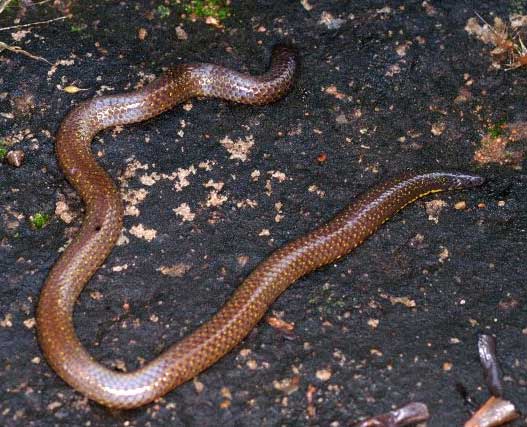
Plectrurus perrotetii (*)
Superregnum: Eukaryota
Regnum: Animalia
Subregnum: Eumetazoa
Cladus: Bilateria
Cladus: Nephrozoa
Superphylum: Deuterostomia
Phylum: Chordata
Subphylum: Vertebrata
Infraphylum: Gnathostomata
Superclassis: Tetrapoda
Cladus: Reptiliomorpha
Cladus: Amniota
Classis: Reptilia
Cladus: Eureptilia
Cladus: Romeriida
Subclassis: Diapsida
Cladus: Sauria
Infraclassis: Lepidosauromorpha
Superordo: Lepidosauria
Ordo: Squamata
Subordo: Serpentes
Superfamilia: Booidea
Familia: Uropeltidae
Genus: Plectrurus
Species: Plectrurus perroteti
Name
Plectrurus perroteti Duméril, Bibron & Duméril, 1854
References
Links
Uetz, P. & Hallermann, J. 2022. Plectrurus perroteti. The Reptile Database. Accessed on 14 May 2020.
Srinivasulu, B., Srinivasulu, C., Ganesan, S.R. & Vijayakumar, S.P. 2013. IUCN: Plectrurus perroteti (Least Concern). The IUCN Red List of Threatened Species 2013: e.T172693A1368076. DOI: 10.2305/IUCN.UK.2013-1.RLTS.T172693A1368076.en
Vernacular names
English: Nilgiri Burrowing Snake
Plectrurus perrotetii, commonly known as the Nilgiri burrowing snake or Perrotet's shieldtail,[1] is a species of harmless snake in the family Uropeltidae. The species is endemic to India.
Etymology
The specific name, perrotetii or perroteti, is in honour of French naturalist George Samuel Perrottet (1793–1867).[2]
Geographic range
P. perrotetii is found in the Western Ghats and hills of southern India.
Description
P. perrotetii is a small snake, growing to a maximum of 44 cm (17+1⁄4 in) in total length (including tail). The head is pointed, and the tail is blunt. It has smooth, glossy scales and is brown in colour.
Biology
Like the common worm snake, Ramphotyphlops braminus, Plectrurus perrotetii is also often mistaken for earthworms, upon which it feeds. It is considered an endangered species, and little else is known about this snake.
References
Species Plectrurus perroteti at The Reptile Database . www.reptile-database.org
Beolens, Bo; Watkins, Michael; Grayson, Michael (2011). The Eponym Dictionary of Reptiles. Baltimore: Johns Hopkins University Press. xiii + 296 pp. ISBN 978-1-4214-0135-5. (Plectrurus perroteti, p. 203).
Further reading
Boulenger GA (1893). Catalogue of the Snakes in the British Museum (Natural History). Volume I., Containing the Families ...Uropeltidæ ... London: Trustees of the British Museum (Natural History). (Taylor and Francis, printers). xiii + 448 pp. + Plates I-XXVIII. (Plectrurus perroteti, p. 161).
Duméril A-M-C, Bibron G, Duméril A[-H-A] (1854). Erpétologie générale ou histoire naturelle complète des reptiles. Tome septième.—Première partie. Comprenant l'histoire des serpents non venimeux [= General Herpetology or Complete Natural History of the Reptiles. Volume 7, Part I. Containing the Natural History of the Nonvenomous Snakes]. Paris: Roret. xvi + 780 pp. (Plectrurus perroteti, new species, pp. 167–168). (in French).
Smith MA (1943). The Fauna of British India, Ceylon and Burma, Including the Whole of the Indo-Chinese Sub-region. Reptilia and Amphibia. Vol. III.—Serpentes. London: Secretary of State for India. (Taylor and Francis, printers). xii + 583 pp. (Plectrurus perroteti, p. 71).
Retrieved from "http://en.wikipedia.org/"
All text is available under the terms of the GNU Free Documentation License

